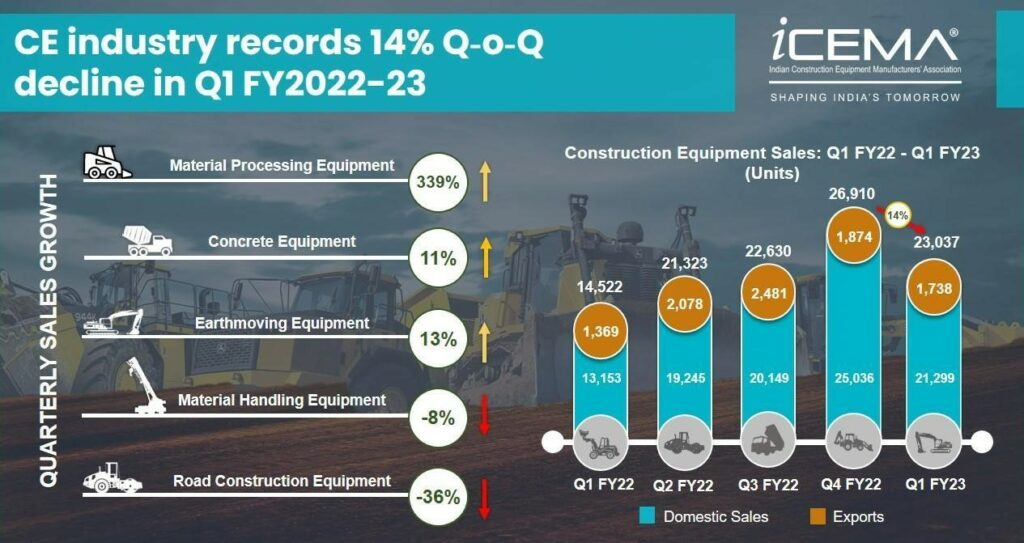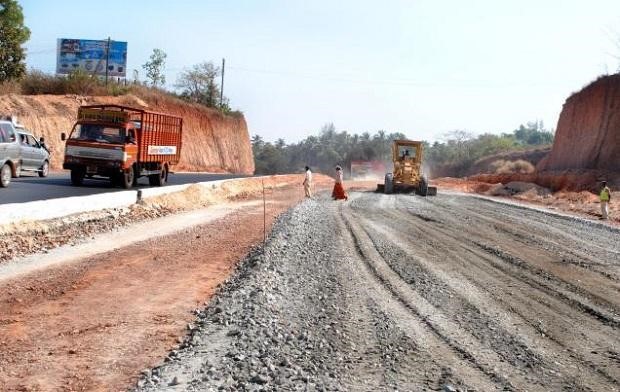National highway construction in India has slowed down to 20.43 km a day during the first four months of the FY 2022-23 according to official data. While the pace of national highway (NH) construction in the country had touched a record 37 km per day in 2020-21, it had slowed to 28.64 km a day in 2021-22, The ministry had constructed 10,237 km in 2019-20, 13,327 km in 2020-21 and 10,457 km in 2021-22. The official target of highway construction has been kept at 12,000 km for the current financial year but construction of 2,493 km of National Highways is completed up to July in 2022-23, as compared to 2,927 km constructed up to July 2021-22, Only 1,975 km of road projects were awarded between April-July in 2022, compared to 2,434 km of road projects awarded in the prior year.
The Ministry has been allocated ₹1,99,107.71 crore for the financial year 2022-2023 compared with ₹1,18,101 crore in last year’s Budget estimate. A large chunk of the additional ₹81,000 crores granted to the Ministry this year is earmarked for investment in the National Highways Authority of India (NHAI), with its allocation seeing a 133% increase (₹76,665 crores) to ₹1,34,015 crores. But the result for the construction of the highway target has not been met yet.
A double impact as CE sales declines
This is a double-blow as ICEMA has reported that the Indian Construction Equipment (CE) industry has witnessed a decline of 8 percent year-on-year (Y-o-Y) in FY22 to 85,385 units from 92,470 units in FY21. As per the annual industry data released by the Indian Construction Equipment Manufacturers Association (ICEMA);
- The earthmoving equipment segment which accounts for nearly three-fourth of the total construction equipment sales in India experienced 14% decline in growth.
- Road construction equipment sales were lower by 10% during the same year.

The primary reasons for the slowdown of highway construction and construction equipment sales
COVID-19 pandemic-related disruptions
The 8% volume de-growth registered during FY22 is largely owing to the second and third waves of COVID-19 pandemic, which adversely impacted the pace of construction activity in the country. It also impacted the supply chain constraining the industry’s ability to cater to the emerging demand.
Longer-than-usual monsoon in some parts of the country
Unprecedented natural calamities like cyclones and heavy rains had also affected construction activity, particularly in the Southern part of the country, further affecting the demand for construction equipment. Equipment utilisation levels have also moderated due to the extended monsoon and its impact on infrastructure activities.
Rise in commodity prices like cement, steel and bitumen
The decline in the pace of construction is also impacted with high prices of construction materials like cement, steel and bitumen.
Emission norms add on the construction equipment price
Icra reported there has been a 10-20% increase in prices of construction equipment, mainly due to increasing input costs along with a change in emission norms. The new emission norms which already made 60 percent of the machines costlier by about 15-20 percent, the continuing jump in commodity prices has added to their problems.
According to the CE manufacturers as shared during EXCON 2021,’ The biggest challenge comes in the form of conversion of BS (III) to CEV Stage IV emission norms. The norms brought about changes in the pricing of construction equipment, incurring around a 30 percent increase in price. Simultaneously the price of steel has also gone up. The industry is quite dependent on the rental business, but the rates have not risen. Rental companies and manufacturers are squeezing in the margin to meet the end meet for contractors’.
The way forward for Indian Construction Equipment Market
Despite the challenges, there has been a steady increase in the sales numbers during the four quarters of the current fiscal. The sales volume has increased by 12% from the previous quarter. This has brought back much-needed growth momentum The ongoing push for infrastructure projects is also expected to continue to increase the demand for stable, safer, advanced tech equipment and more productive solutions in the construction equipment. There are a lot of positive takeaways;
- Three segments namely material handling, material processing and concrete equipment registered positive growth during the year. Exports of construction equipment also increased significantly by 60 per cent in FY22 over FY21 as per ICEMA. Mining equipment too has been stable.
- The surge in railway infrastructure development projects across India such as Delhi-Mumbai Trade Corridor, Chennai Metro Rail ($14.9 billion) and Diamond Quadrilateral is seeing good demand.
- The government continues its thrust on infrastructure development through the announcement of mega plans including the National Infrastructure Pipeline, Gati Shakti Masterplan, National Monetisation Plan etc.
- Govt. plan to increase the award of contracts for highway construction, new railway lines, water management, development of ports
- National Bank for Financing Infrastructure and Development (NaBFID) which is expected to be operational by the first quarter of the current fiscal will support the development of long-term non-recourse infrastructure financing, including the development of the bonds and derivatives markets necessary for infrastructure financing, and to carry on the business of financing infrastructure.
- Prices of steels are moderating, the government has announced waiving of customs duty on the import of some raw materials, including coking coal and ferronickel, used by the steel industry. As of mid-June, prices are already at Rs 62,000-64,000 per tonne and can be expected to trend below Rs 60,000 per tonne by the end of the fiscal.
- The introduction of newer technologies in the industry such as the adoption of alternate fuels can help the industry attain sustainable growth in the future
Conclusion
Construction equipment manufacturers are seeing business coming back to normalcy backed by announcements such as the Gati Shakti, National Infrastructure Pipeline etc and the institutionalising of NABFID. The construction equipment market is hopeful to get back on track based on recent developments of reduced commodity prices. Government is eyeing to attract foreign investors In line with the objective, ICEMA has developed a first-of-its-kind ‘CE Industry catalogue’ that showcases the manufacturing strengths of the Indian CE industry. Aiming to promote Indian CE products in the international markets, the catalogue will also help attract investments in the Indian CE industry through global suppliers setting up manufacturing bases in India. In the context of a changing landscape, the prospects of construction equipment manufacturers in India seems to be in positive node.


